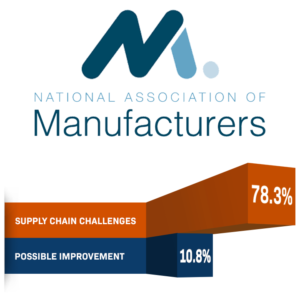
Consolidating Suppliers Reduces OEM Supply Chain Risk
January 27, 2023
Sustained supply chain challenges continue to push Original Equipment Manufacturer (OEM) risk upward. At the same time, those market conditions create an opportunity for OEMs to benefit from consolidating their supplier bases.
A drive toward consolidation gives OEMs a fresh lens through which to refocus on working with supplier partners that are committed to cost reduction, quality and effective production management.
Benefits of Supplier Consolidation

In the National Association of Manufacturers’ 3Q 2022 outlook, 78.3% of manufacturing leaders listed supply chain disruptions as a primary business challenge, with only 10.8% believing improvement would occur by the end of the year. In a study released in July 2022, respondents said they expect “significant” supply chain disruptions to continue through 2023.
Thus, the environment remains ripe for OEMs to better manage supply chain challenges by working with fewer, but stronger, suppliers. For example, placing more work with proven supplier partners can give OEMs:
- Greater delivery predictability. Transparency in trusted supplier partner relationships gives OEMs insights into delivery realities and creates options for flexibility in production schedules to accommodate delivery disruptions.
- Less exposure to geopolitical and geoeconomics issues. Keeping a significant portion of work close to home mitigates the risk created by international disturbances. Often, a trusted domestic supplier can increase production to offset an international supplier’s delay.
- Improved production quality. Particularly when the components being manufactured are complex, custom engineered and built to spec, a smaller number of suppliers can do a better job of fully understanding and adhering to critical quality requirements than a larger, less-engaged supplier base can.
- Lower internal costs. Complexity adds cost. A consistent, consolidated supplier base reduces the time OEMs must otherwise spend on administrative tasks like tracking numerous contracts and purchase agreements. A streamlined process cuts down on errors and inefficiencies, saves time and increases productivity.
- Leverage to negotiate a supplier’s help in offsetting freight and other costs. When an OEM’s supplier base contracts, its purchasing power increases. The smaller number of core suppliers that handle large portions of the business are motivated to serve as partners, working collaboratively to find cost efficiencies in freight, handling and other shipping fees.
- Labor shortage mitigation. Supplier partners who know an OEM plans to maintain a long-term relationship likely will be willing to make investments in people, processes and technologies that reduce labor shortage impacts.
- Better OEM-supplier relationship outcomes. Relationships with a small group of trusted suppliers give OEMs freedom to enlist those suppliers as strategic allies in anticipating supply chain problems, developing joint solutions and responding to opportunities.
Supplier Consolidation Considerations
 ncreasing freight costs, labor shortages and geopolitical issues that affect the supply chain will affect OEMs significantly for years to come. Any risk that can be eliminated to better streamline production and distribution will swiftly return benefits. OEMs that haven’t already consolidated their suppliers should strongly consider it now, using careful, goal-oriented evaluation and decision making, including:
ncreasing freight costs, labor shortages and geopolitical issues that affect the supply chain will affect OEMs significantly for years to come. Any risk that can be eliminated to better streamline production and distribution will swiftly return benefits. OEMs that haven’t already consolidated their suppliers should strongly consider it now, using careful, goal-oriented evaluation and decision making, including:
- Weigh the intangibles. Suppliers worth keeping on the roster will be deeply committed to exceptional customer service, getting paperwork and other details correct and openness to coordinating with OEMs to drive cost reductions.
- Be amenable to using suppliers that work with competitors. The labor forces at competitors’ suppliers already are trained and proven to be successfully producing similar parts. The learning curve will be minimal, and the quality level is likely to be high.
- Assess which suppliers meet third-party industry standards. Experienced supplier-partners will have previously secured numerous environmental, safety and ISO certifications. They will be able to follow their customary, proven processes to gain requisite certifications – if they don’t already have them – and meet individualized OEM specifications.
- Determine the supplier’s willingness to invest in the relationship. Long-term supplier partners may be willing to install an OEM’s existing equipment in their facilities, for example, invest in automation or purchase equipment specifically suitable for an OEM’s product lines.
- Look beyond purchase order pricing. A supplier that works cooperatively with OEMs to develop clear specifications, capably produces high-quality parts without requiring extensive back-and-forth during production and provides excellent finished products on time will reduce overall costs, usually resulting in a better total cost equation.
OEMs are navigating unprecedented supply chain disruptions and skilled labor shortages. Consolidating their supplier networks is a smart, strategic step that can allow OEMs to leverage key suppliers’ expertise and thinking to solve problems more effectively.